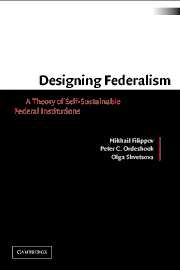Book contents
- Frontmatter
- Contents
- List of Figures
- List of Tables
- Preface
- Acknowledgments
- 1 Federations and the Theoretical Problem
- 2 Federal Bargaining
- 3 Two Cases of Uninstitutionalized Bargaining
- 4 Representation
- 5 Incentives
- 6 Political Parties in a Federal State
- 7 Institutional Sources of Federal Stability I
- 8 Institutional Sources of Federal Stability II
- 9 Designing Federalism
- References
- Name Index
- Subject Index
3 - Two Cases of Uninstitutionalized Bargaining
Published online by Cambridge University Press: 03 December 2009
- Frontmatter
- Contents
- List of Figures
- List of Tables
- Preface
- Acknowledgments
- 1 Federations and the Theoretical Problem
- 2 Federal Bargaining
- 3 Two Cases of Uninstitutionalized Bargaining
- 4 Representation
- 5 Incentives
- 6 Political Parties in a Federal State
- 7 Institutional Sources of Federal Stability I
- 8 Institutional Sources of Federal Stability II
- 9 Designing Federalism
- References
- Name Index
- Subject Index
Summary
The perilous moment for a bad government is when that government tries to mend its ways.
Tocqueville 1955: 177All of the socialist regimes in Europe depended for their survival on maximizing economic growth and maintaining the party's economic and political monopoly.
Bunce 1999: 56It is a fact of current life that secession movements are under way, with more to come. It is also a fact that there is growing support for including some sort of right to secede in a number of constitutions.
Allen Buchanan 1991: 148Because the fundamental problem of federal design is to supply a stabilizing institutional context for bargaining over inherently redistributive policy, and because these institutions, many of which are constitutional, are themselves subject to negotiation and reinterpretation, the idea of a constitution as a living document reflects the conventional wisdom that such things as the division of prerogatives and jurisdictions between federal subjects and the federal center should not be impervious to adjustment and redefinition as society evolves and circumstances change. If these adjustments are to remain incremental and evolutionary, however, then bargaining and renegotiation must be set in some larger and stable institutional context – a layer of institutional structure that is somehow further removed from the pressures of bargaining but which nevertheless directly impacts and regulates it. And if, for convenience, we label such institutions “constitutions” in a broad sense, then an essential part of federal design, as we outline matters in the previous chapter, is to create a constitutional supergame that encompasses federal bargaining and restrains it so that Level 1 provisions are more than mere words on paper.
- Type
- Chapter
- Information
- Designing FederalismA Theory of Self-Sustainable Federal Institutions, pp. 76 - 110Publisher: Cambridge University PressPrint publication year: 2004



